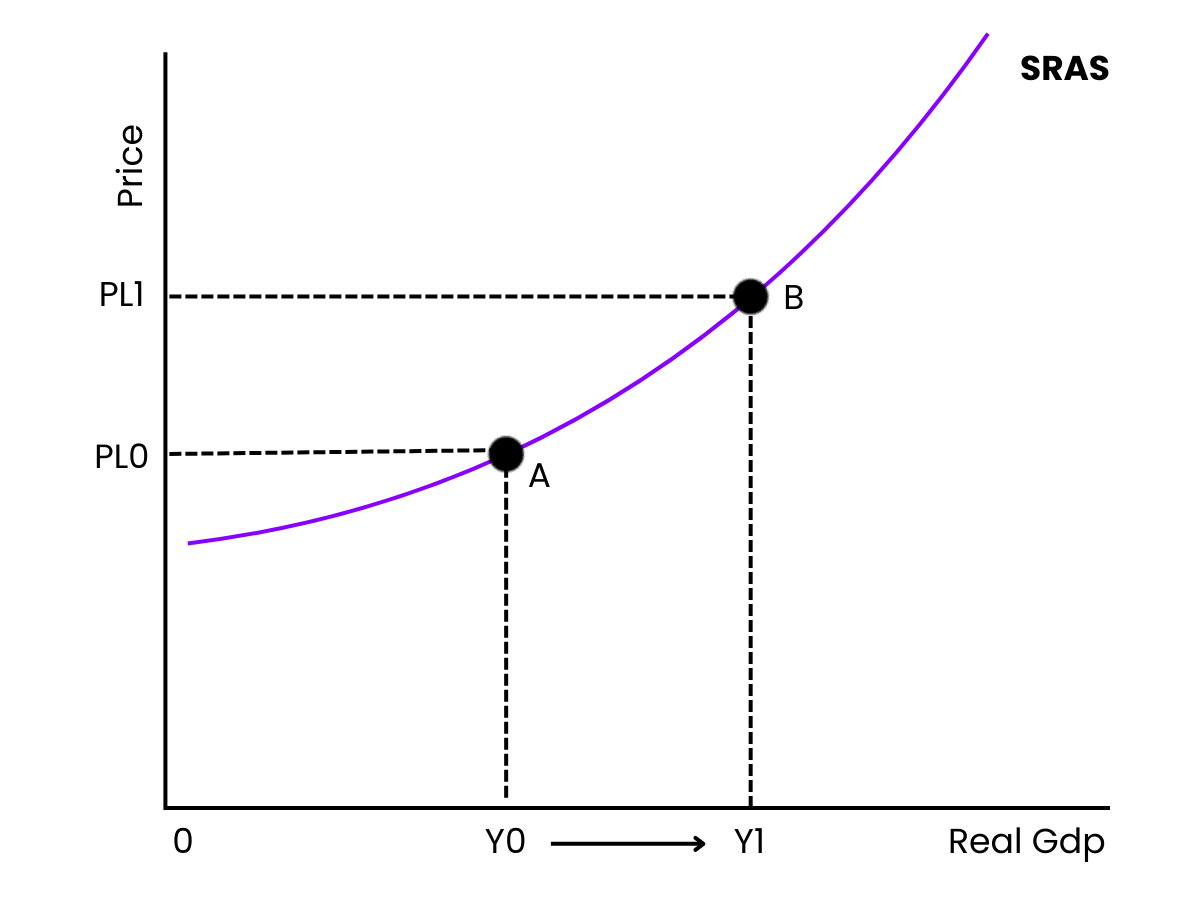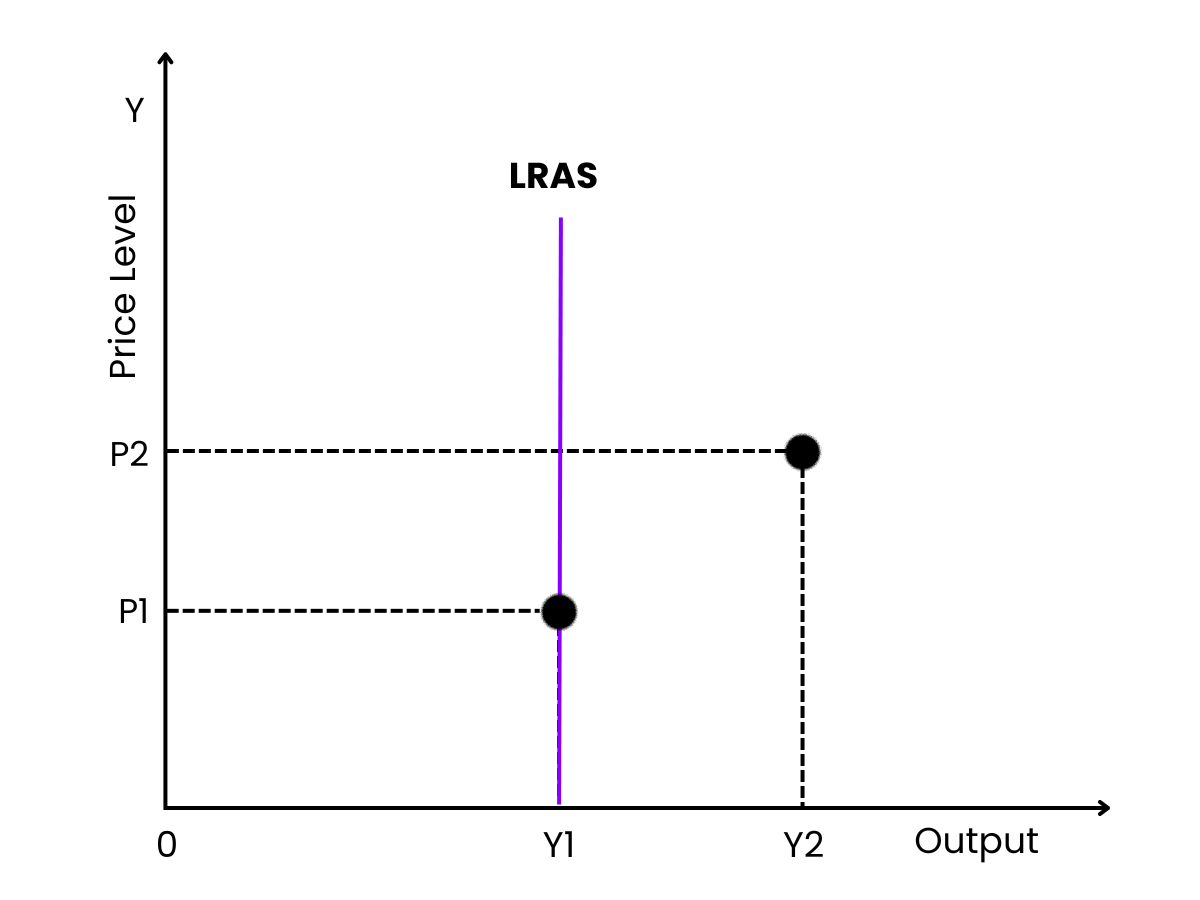In AP Macroeconomics, understanding short-run and long-run aggregate supply is essential for analyzing economic performance. Short-run aggregate supply reflects how businesses respond to price changes with fixed input costs, while long-run aggregate supply represents the economy’s potential output when all resources are fully utilized. Together, they provide insights into inflation, production, and overall economic stability.
Learnig Objectives
Understand the characteristics and differences between short-run and long-run aggregate supply, including how SRAS is influenced by factors like input prices and productivity. Analyze the implications of shifts in both SRAS and LRAS on the economy, and evaluate the effects on output and price levels.
Here are detailed notes on short-run and long-run aggregate supply for your AP Macroeconomics preparation:
Short-Run Aggregate Supply (SRAS)

- Definition: SRAS reflects the total output that firms are willing to produce at different price levels in the short run, holding some input costs fixed.
- Upward Sloping Curve: The SRAS curve is upward sloping because, in the short run, as the price level increases, firms are willing to supply more goods and services due to higher profit margins. This is often due to:
- Sticky wages: Wages are often slow to adjust to changes in price levels, so when prices rise, firms can benefit from higher revenue without immediately increasing wages.
- Resource prices: Prices of inputs like labor and materials may not adjust quickly, leading to increased profitability at higher output levels.
Key Factors Influencing SRAS:
- Input Prices: Changes in the costs of production (e.g., wages, raw materials) can shift the SRAS curve. An increase in input costs shifts SRAS to the left.
- Productivity: Improvements in productivity (e.g., technology advancements) can shift SRAS to the right.
- Supply Shocks: Events like natural disasters or geopolitical issues can impact supply negatively or positively.
Long-Run Aggregate Supply (LRAS)

- Definition: LRAS represents the total output of an economy when all resources are fully employed, and it reflects the economy’s potential output.
- Vertical Curve: The LRAS curve is vertical at the natural level of output (full employment level), indicating that in the long run, the economy’s output is determined by resources and technology, not by the price level.
Key Features of LRAS:
- Full Employment: LRAS corresponds to the level of output that can be sustained without causing inflation. At this level, all resources are fully utilized.
- Changes in LRAS: Long-run aggregate supply can shift due to:
- Changes in resource quantity (e.g., labor force growth).
- Changes in technology and productivity.
- Changes in institutional factors (e.g., government policies, regulations).
Shifts in Aggregate Supply
- Leftward Shift: Causes include increased production costs, negative supply shocks, or decreased productivity. This results in higher prices and lower output.
- Rightward Shift: Causes include decreased production costs, positive supply shocks, or increased productivity. This leads to lower prices and higher output.
Examples
Example 1: Oil Price Shock
A sudden increase in oil prices raises production costs for many industries, shifting the short-run aggregate supply curve to the left and increasing inflation.
Example 2: Technological Advancement
A breakthrough in manufacturing technology increases productivity, shifting the long-run aggregate supply curve to the right, indicating higher potential output and economic growth.
Example 3: Labor Market Changes
A significant increase in the labor force due to immigration can shift the long-run aggregate supply to the right, enhancing economic capacity and growth potential.
Example 4: Natural Disaster
A hurricane devastates infrastructure, leading to increased production costs and lower output. This event shifts the short-run aggregate supply curve to the left, causing higher prices.
Example 5: Policy Changes
Government investment in education and training can enhance workforce skills, shifting the long-run aggregate supply curve to the right, which boosts overall productivity and economic output.
MCQs
Question 1
What happens to the short-run aggregate supply (SRAS) curve when production costs increase?
A) It shifts to the right
B) It shifts to the left
C) It remains unchanged
D) It becomes vertical
Answer: B) It shifts to the left
Explanation: An increase in production costs, such as higher wages or raw material prices, reduces firms’ willingness to supply goods at existing price levels, shifting the SRAS curve to the left.
Question 2
Which of the following factors would most likely shift the long-run aggregate supply (LRAS) curve to the right?
A) Decrease in consumer spending
B) Increase in technology and productivity
C) Higher interest rates
D) Increased inflation expectations
Answer: B) Increase in technology and productivity
Explanation: Technological advancements and improvements in productivity enhance the economy’s capacity to produce goods and services, shifting the LRAS curve to the right.
Question 3
In the long run, what primarily determines the position of the long-run aggregate supply (LRAS) curve?
A) Price levels
B) Resource availability and technology
C) Government spending
D) Aggregate demand
Answer: B) Resource availability and technology
Explanation: The LRAS curve reflects the economy’s potential output, which is determined by the quantity and quality of resources and the level of technology available, rather than price levels.

